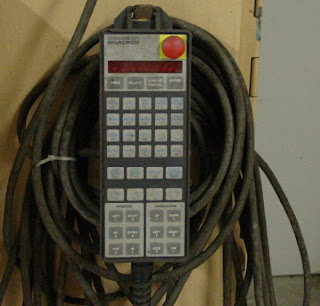Servomechanism is an automatic device for the control of a large power output by means of a small power input or for maintaining correct operating conditions in a mechanism. It is a type of feedback control system. The constant speed control system of a DC motor is a servomechanism that monitors any variations in the motor's speed so that it can quickly and automatically return the speed to its correct value. Servomechanisms are also used for the control systems of guided missiles, aircraft, and manufacturing machinery.
A servomechanism is unique from other control systems because it controls a parameter by commanding the time-based derivative of that parameter.
Servomechanism may or may not use a servomotor.
The common type of servo provides position control. Servos are commonly electrical or partially electronic in nature, using an electric motor as the primary means of creating mechanical force. Other types of servos use hydraulics, pneumatics, or magnetic principles. Usually, servos operate on the principle of negative feedback, where the control input is compared to the actual position of the mechanical system as measured by some sort of transducer at the output. Any difference between the actual and wanted values (an "error signal") is amplified and used to drive the system in the direction necessary to reduce or eliminate the error. An entire science known as control theory has been developed on this type of system.

Small R/C servo mechanism is shown in the figure above the parts as labelled are:-
1. electric motor
2. position feedback potentiometer
3. reduction gear
4. actuator arm
When at I2It pune whe learned about the wiring and working of a servo motor .
Servo Wiring
All servos have three wires:
Black or Brown is for ground.
Red is for power (~4.8-6V).
Yellow, Orange, or White is the signal wire (3-5V).

Servomechanisms were first used in military fire-control and marine navigation equipment. Today servomechanisms are used in automatic machine tools, satellite-tracking antennas, remote control airplanes, automatic navigation systems on boats and planes, and antiaircraft-gun control systems. Other examples are fly-by-wire systems in aircraft which use servos to actuate the aircraft's control surfaces, and radio-controlled models which use RC servos for the same purpose. Many autofocus cameras also use a servomechanism to accurately move the lens, and thus adjust the focus. A modern hard disk drive has a magnetic servo system with sub-micrometre positioning accuracy.
Thier only disadvantage is that these motors are much more costlier than stepper or dc motors.
Cincinati Milacron T3 Arm
The Cincinnati Milacron T3-776 robot is shown in .the picture. It is apparent that the
geometry of this manipulator is very similar to that of the Puma robot, i.e. the second
and third joint axes are parallel and the last three joint axes intersect at a point. The
detailed solution will therefore be very similar to that for the Puma robot. This solution
will be followed by a general discussion of a geometric solution that does not require that the hypothetical closure link be determined.
This robot is a more classically designed industrial robot. Designed as a healthy compromise between dexterity and strength this robot was one of the ground breakers, in terms of success, in factory environments. However, while this robot was a success in industry its inflexible interfacing system makes it difficult to use in research.

The Cincinnati Milacron T3-786 robot was the workhorse of the robotics industry for many years. Almost indestructable, thousands of these machines are still in production in hostile, 24 hour manufacturing environments. Many manufacturers have come to depend on these machines, and are reluctant to give them up.
This robot is a more classically designed industrial robot. Designed as a healthy compromise between dexterity and strength this robot was one of the ground breakers, in terms of success, in factory environments. However, while this robot was a success in industry its inflexible interfacing system makes it difficult to use in research.





No comments:
Post a Comment